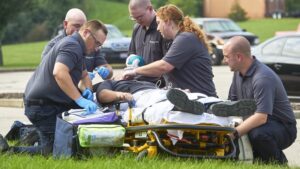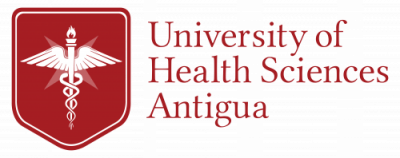
He’s got a collapsed lung! Call the helicopter!
The patient was a 15-year-old male who was having difficulty breathing.
We were in the backcountry of Idaho on a Memorial Day weekend, and a long way from a hospital. I was a volunteer paramedic with a small ambulance company that covered an area the size of Rhode Island. This weekend we were providing coverage for a dirt bike race.
About three hours into an uneventful shift a Jeep pulled up and my patient got out of the passenger seat. He had jumped from a bridge into the river below, but had misjudged the depth of the water and struck his chest hard against the rocks. He was conscious, could answer questions, but was finding it harder and harder to breath.
I started him on oxygen, but could see it was offering little help as the panic in his eyes grew. I asked my dispatcher to call for an air ambulance from Boise, which was around 100 miles away. A long way by road, but a short flight for a helicopter. The air ambulance was always our lifeline in situations like this. But today was a busy weekend, and all of the choppers were busy.
I was on my own twenty-five miles in the backcountry on dirt roads. And once we got to the main road, it was another 100 miles to the nearest hospital. I was starting to feel a little panicked as well. But one thing I had learned, if you feel panicked, you keep it to yourself. The patient does not want to see their provider scared.
I started my physical exam, but could hear no breath sounds on the right side. It was as if his right lung was not working. I tried again… nothing. Then it struck me! This was what the textbooks said a pneumothorax would sound like. The patient was exhibiting the classic signs of a collapsed lung. His left lung was still working, but was providing only half the oxygen he needed. What my patient needed was a surgeon, and fast, to decompress the right lung by inserting a long needle so that the lung could re-expand.
I asked my dispatcher to let the air ambulance know this was a critical call. We would be starting out of the mountains in the ambulance, and could they meet us at a forest service airfield about thirty miles away. They said they would try; but no promises.
Just as we were loading our patient into the ambulance, another call came in. This was a much more serious call – two motorcycles had gone into a ravine, and one of the drivers was unconscious and bleeding heavily. The ambulance, and my crew, would go to that call. I would head down the mountain with an oxygen tank, my trauma bag, and my increasingly terrified teenage patient in the back seat of a Jeep.
It was a long trip down, but in the end, the helicopter from St Al’s was able to meet us. I was excited to see the helicopter rising above the tree line and headed in a straight track towards the nearest trauma center where I knew my patient would be well cared for.
I felt gratification and pride; the pride that comes from doing a job well done, and actually helping those in need. Plus, experience like this made me exactly what medical schools were looking for!
What makes the perfect applicant to medical school?
Medical schools look at your extracurricular activities as part of the admissions process. Medical schools want to see the complete picture of who you are, and how your non-medical activities make you not only a more well-rounded person, but also contribute to community service and teamwork skills
The American Association of Medical Colleges (AAMC) publishes a list of fifteen characteristics that all medical students should have, including community service and teamwork, that medical schools use to assess applicants.
Medical schools also look for exposure to medicine, such as through work experience or volunteering, to gauge how well you understand the challenges of becoming a physician.
The perfect applicant combines experience with community service.
What if there was a way to combine extracurricular activities that show service and teamwork skills with exposure to medicine that demonstrates you understand the challenges of becoming a doctor? Well, there is, and it involves becoming an emergency medical technician (EMT).
What is an EMT?
An EMT is a first responder who works for agencies, such as fire departments and ambulance companies, that respond to emergency calls in a pre-hospital environment. When you call 911 or 999 and ask for an ambulance, then that ambulance is staffed by emergency medical technicians who specialize in pre-hospital emergency care.
EMT’s provide emergency care, such as stopping bleeding, giving oxygen, stabilizing broken bones, defibrillating those who are having heart attacks, and transporting patients to the nearest hospital. In many places, EMT’s give immunizations, follow-up with patients who have been discharged from the hospital, and perform some public health functions.
How can I become an EMT?
Start by doing an online search for programs in your local area. These might be offered by your local community college, or even by your local fire department/ambulance company. Chances are, there is a part-time EMT program available in your community.
Compared to the premedical coursework, you will find the EMT coursework relatively easy; but applied, which is good.
A sample part-time program is often taught one night per week from 6-10 PM. This usually lasts about two months.
After you finish the class, you will be assigned to an ambulance to get practical experience over the course of several weeks.
Altogether, the entire course will usually be 300-400 hours in length. Once you complete the course and the practical experience, you will take either a state or national examination to become a registered emergency medical technician.
After that, start looking in your local area either for paid work or volunteer work. Medical schools don’t care if you were paid or volunteered, they just want to see the experience. Paid is always better for your pocket book; but volunteer can be great as well, as it often times leads to more leadership opportunities, such as becoming a shift supervisor.
What’s the value of becoming an EMT before medical school?
Provide patient care
A rare chance for someone to provide direct patient care after less than 1,000 hours of training will certainly look good on your resume and application to medical school. Plus, you will learn to provide basic emergency care, work with patients, learn valuable communication skills, teamwork skills, and start amassing your medical knowledge and skills even before medical school.
Be exposed to medicine
Most of your medical school colleagues will have spent a few weeks shadowing a physician. While this is great experience, did they actually get to interact with patients? Did they get to be the provider of medical care to those patients? Or did they just quietly observe, and later ask questions? Most likely the latter. You will have been in the field, providing care, and interacting with physicians, nurses, laboratorians, radiographers, and others in the emergency room. Those are skills and experiences anyone would dream of having before medical school.
Learn to deal with people at their worst
When people call for an ambulance it’s not because they are having a great day. Someone is in trouble, and they need your assistance. While many people will be polite and kind, such as the old woman who falls and breaks her hip, others will be unpleasant and call you every dirty name you can think of. The drunk who has crashed his car breaking his tibia and fibula; the illegal drug user who has been in a fight with police and now needs to be bandaged up before going to jail; the psychiatric patient who has tried to take her own life and needs to be transported to the ER. Learning to deal with people when they are having their worst day is valuable experience for your clinical years.
Acclimate to dealing with emergencies calmly
Want to bring calm to the storm while others are panicking? Well, become an EMT and that is what you will have learned to do. When your fellow medical students are shaking so badly while trying to insert a needle that you think they have Parkinson’s disease, you’ll be cool, calm, and in control, because you’ve been on your own in the field doing these things.
A rewarding opportunity to help those who truly need you
People call an ambulance when they need help. You’re the person who comes to their rescue. I remember helping the firefighters pull a family of four, including two small children, from a car that was hanging over the edge of a dam in rural Idaho. I’ve never been hugged so tight in my life as I was by that mother. It felt good. And the homemade cookies she sent tasted even better. And while not every call ends in a hug and cookies, just knowing that you made a difference is an awesome feeling.
Will becoming an EMT help me get accepted to UHSA?
UHSA looks at the whole person when we consider applicants. We look at your academic qualifications to make sure you have the required premedical courses. But we also look at your life experience and your motivation to become a physician. And while we do not specifically require you to have volunteer exposure to medicine, we encourage this, and look favorably on it when looking at your application.
Join the UHSA Family
If you are ready to make your dream of becoming a doctor reality, then UHSA is right for you. We have been producing physicians for over thirty-eight years (1982), and know what it takes to succeed. We offer three programs to help you live your dream.
Accelerated Premedical Program
This program gives you all of the credits you need to enter our MD program, and it will do it in the shortest time possible. Our premedical program is taught using problem-based learning, and is focused on medical issues, so that you are highly prepared for medical school.
If you already have the prerequisites for admission to medical school, then the traditional program is for you. Taught using innovative problem-based learning methods, clinical vignettes, and a highly-experienced international faculty, this is a great way to live your dream of becoming a practicing doctor. We offer three start dates per year, including January, May, and September.
Combined MD/Masters of Public Health (MPH) Program
You can now earn your MD and your MPH at the same time! Our innovative dual degree program is perfect for those who want an internationally recognized qualification that will better their chances of being accepted to residency programs, as well a valuable qualification for working in international health, public health, or preventative medicine.
Contact our Admissions Team to begin living your dream!

